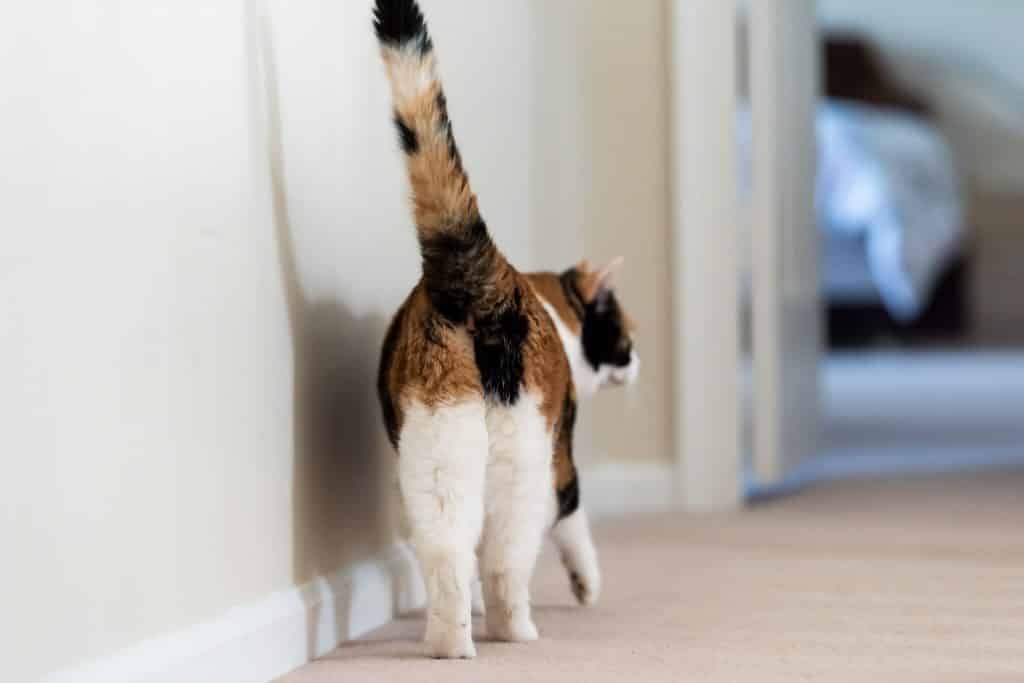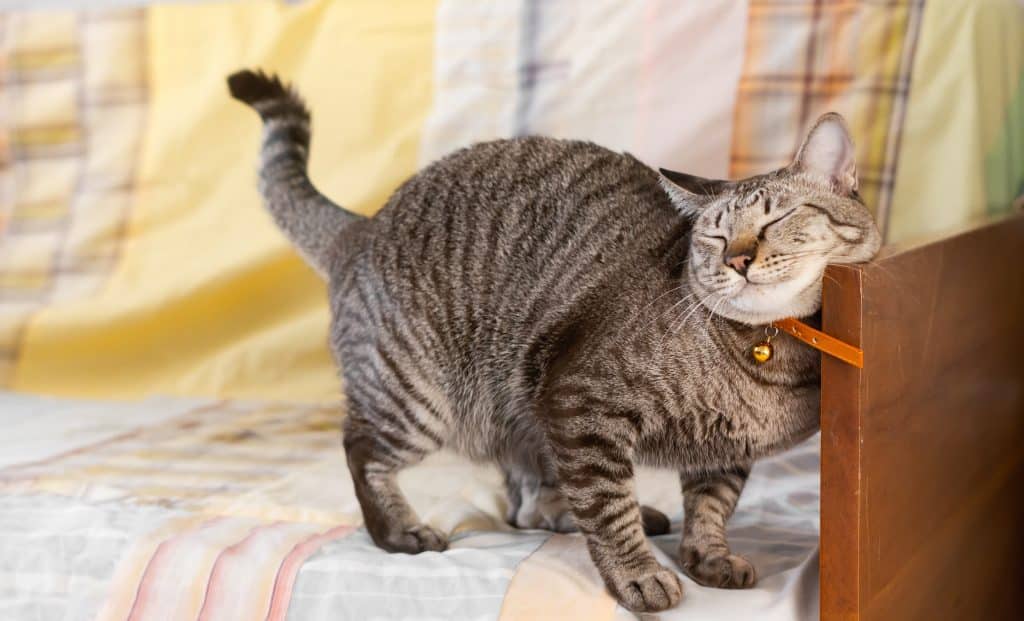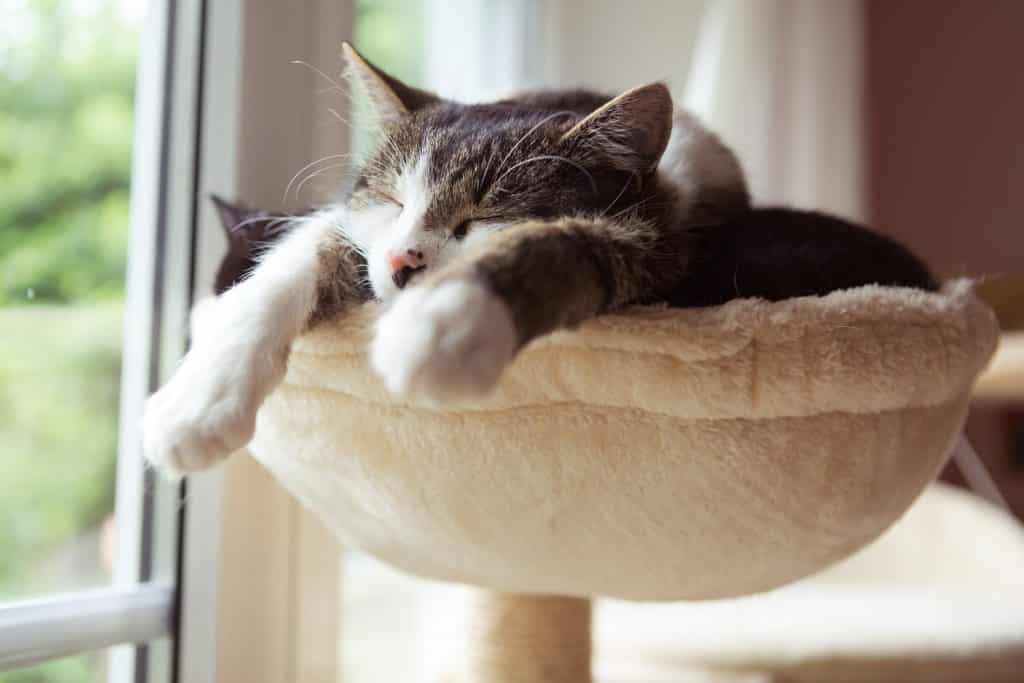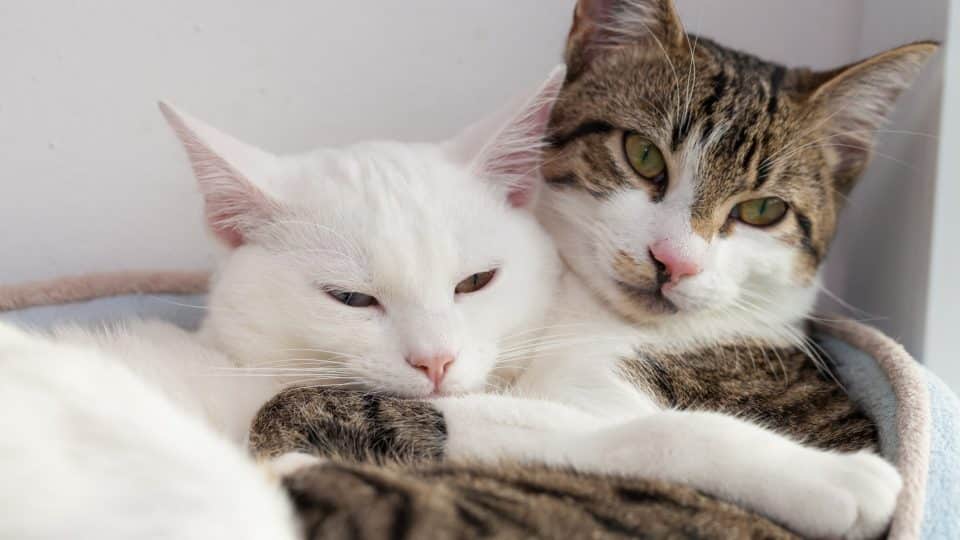- Not a substitute for professional veterinary help.
Got a female cat? Most likely, your vet has already recommended or started the conversation about getting her spayed. But in certain circumstances, like taking in a stray, you might not be able to get your cat spayed before she goes into heat. Cue howling and increased need for attention, and now you’re probably wondering how long will your cat’s heat last.
Experts say cats are in heat on average for seven days, but it can be anywhere from 3-20 days, often between February and October. This internal state can happen multiple times a year, and you might notice your cat exhibiting some pretty unusual behaviors. Let’s break down everything you need to know and expect about a cat going into heat.
Recognizing the Signs of Your Cat In Heat
Predicting when a cat is going into heat can be tricky. However, recognizing that your cat is currently in heat is significantly easier. Recognizing the signs of heat can also help you schedule and prep for your cat’s spay appointment—or start counting down to the next days.
Common behaviors of cats in heat include:
- Increased vocalization. You’re probably used to a few well-timed “meows” from your cat. When a cat is in heat, their vocalization goes into overdrive. Cats will yowl, cry, and meow. These vocalizations will likely happen often and loudly as a way to attract male cats.
- Increased affection. Cats in heat can be extra affectionate with their humans. When they’re in heat, cats love to be pet, stroked, and scratched—particularly on their back and rear. So, if your cat is intact and more snuggly and affectionate than usual, she could be in heat.
- Spraying urine and menstruation. If your cat is spraying urine, this is another signal your cat is ready to mate and in heat. Cats might also bleed a tiny amount during their heat. This is completely normal. If it’s more than a little blood, it could indicate something is wrong, such as a urinary tract infection. If that’s the case, contact your vet right away.
- Rubbing their face on you or other items around the house. Like spraying, cats rub their face on things to spread their scent. So if you notice your cat rubbing their face on your jeans, couch, or floor, it could be a sign they’re trying to spread their scent far and wide in hopes of attracting a mate.
- Putting their hindquarters in the air. If your cat puts their butt in the air and gives it a little wiggle, it’s another signal they’re on the market for a mate.

iStock/ablokhin
How Often Does A Cat Go Into Heat?
When a cat is in heat, the cycle can last anywhere from 1 to 20 days. While the cycle length is pretty standard, the frequency can be a bit harder to pin down.
Cats are polyestrous, which means they go into heat multiple times per year—and can become pregnant numerous times a year. The time between cycles can last anywhere between a few days to a few weeks. So if your cat had an unplanned pregnancy, watch out because she can go into heat in as little as two weeks after giving birth to her litter.
Unlike human females, who have a regular reproductive cycle throughout the year, a cat’s reproductive cycle changes with the seasons. The hormonal cycle of free-roaming cats is triggered by sunlight—which explains why kitten season is typically May to June. You’ll notice female cats beginning their cycles of heat in near February with the lengthening of days. They’ll be less likely to go into heat when the days become shorter and darker in the fall.
But sunlight isn’t the only cause for a domestic cat to go into heat. The hormonal cycle of an indoor cat can be triggered by artificial lighting, so they can go into heat at any time of the year, seemingly without warning.
At What Heat Stage Can My Cat Get Pregnant?
The term “in heat” refers to the time during a cat’s reproductive cycle when she can become pregnant. Estrus is the heat stage when cats can get pregnant. Cats only experience being in heat when they reach sexual maturity, which is typically around the four-month mark.
Depending on your cat’s genetic makeup and breed, they may hit sexual maturity slightly earlier or later. It’s important to note that female cats feel no pain when they go into heat, although they might be somewhat uncomfortable.
The stages of a cat’s heat cycle
According to Dr. Brenda Griffin, DVM, of the Scott-Ritchey Research Center, vets divide a cat’s hormonal cycle into five stages:
- Proestrus. Female cats will begin attracting the neighbor tomcats with vocalization and body language cues like rubbing against people, objects, and other cats. She’ll also stretch, expose her belly, and stick her hindquarters in the air. During the twelve hours to three days of this phase, she’ll attract but turn down her male suitors.
- Estrus. For the next one to twenty-one days (average of four to seven), female cats will experience a surge of the hormone estradiol. She’ll have some discharge and experience an enlarging of her genitals, but that will typically go unnoticed by pet parents. Your cat may spray and mark during estrus, but this behavior isn’t common. When she’s approached by a tomcat (male cat), she’ll crouch with her hindquarters in the air.
- Interestrus. If a cat didn’t breed during the estrus phase, she’ll enter the interestus phase. This is the period of hormonal rest and lowering of estradiol before beginning a new heat cycle. The average rest between heat cycles is one to three weeks.
- Diestrus. If a female was impregnated during the estrus phase, then diestrus follows. The queen will start producing more hormones, like progesterone. Your female cat won’t continue signs of breeding like rolling around or putting her hindquarters in the air.
- Anestrus. During the anestrus phase, cats won’t be in heat. In free-roaming cats, the anestrus phase typically occurs between October and January.

iStock/bombermoon
How Can You Keep Your Cat From Going Into Heat?
Heat behaviors can be problematic for a cat parent. Not to mention that if your cat gets pregnant, you’ll have another issue to tackle. So, the question is, how can you keep your cat from going into heat?
The only way to keep your cat from going into heat is to get her spayed. “Healthy kittens can be spayed as early as six to eight weeks of age in some circumstances, and we recommend that all cats be spayed by five months of age,” says Dr. Erin Katribe, DVM at Best Friends Animal Society. Ideally, female cats should be spayed before their first heat cycle, which can occur as early as four months old.
During a spay, your cat or kitten will safely have her ovaries and uterus removed—known as an ovariohysterectomy. This might sound like a major surgery, but most cats and kittens can go home the very same day of their spay.
If your cat is already in heat, it’s safe to spay her. Plus, spaying cats and kittens supports their long-term health. Studies show spaying reduces the risk of mammary cancer by 91% and eliminates the risk of the life-threatening uterine infection pyometra. In fact, if your cat is experiencing a very loud and prominent heat cycle, spaying will stop the cycle.
Benefits of Spaying and Neutering Cats
Male cats typically become sexually mature around the same age female cats do—as young as four months old. Only female cats go into heat, but it’s just as beneficial to neuter your male cat as it is to spay your female cat. According to Dr. Gary Richter, DVM, Rover’s resident veterinarian on The Dog People Panel, the benefits of neutering male cats include the following:
- Eliminating the chances of unplanned reproduction.
- Eliminating the risk of testicular cancer.
- Reducing the production of testosterone decreases the likelihood of pet-to-pet aggression.
- Minimizing the likelihood of urine spraying.
- Reducing a cat’s tendency to roam (or door dash) looking for a mate.
In general, Dr. Richter says that neutering male cats reduces behavioral issues and improves the quality of life for your pet. Male cats are prone to weight gain and could experience urinary tract disease after being fixed, so talk with your vet about healthy life choices for your neutered cat.

iStock/w-ings
Takeaway: Spaying Prevents Heat and Benefits Your Cat’s Health
“If you or someone in your family is hesitant to spay or neuter your pet, you are not alone,” Dr. Richter says. “There are, however, plenty of great reasons to spay or neuter and very few reasons not to.” Spaying and neutering don’t just prevent your cat from going into heat, having behavioral problems at home, or reduce the risk of life-threatening conditions—fixing your cat has a huge impact on shelter and rescue programs.
Spaying a kitten before her first heat cycle will keep her from having a litter to look after—because kittens as young as four months old can become pregnant. Pregnancy for a cat can be risky, Katribe says. With millions of cats and kittens seeking forever homes in shelters, she adds that the risk just isn’t worth it. “The gestation period for cats is only 64 days, so females can have multiple litters per year,” Shannen McNee, CCBC at the Toronto Humane Society says. “This influx of kittens puts a strain on shelter and rescue organizations because often there are more kittens than resources to appropriately care for each of their individual needs.”
If you think your cat might be in heat or if she has already had a litter, it’s not too late to talk with your vet about the benefits of fixing your cat. To find a low-cost spay or neuter clinic near you, check out this link. And you can find funding options provided by the Humane Society here.


